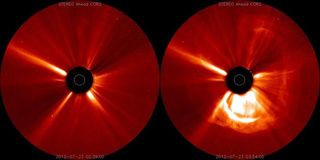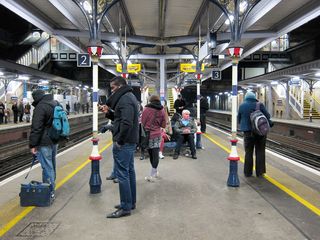
Solar Eruption Could Help Earth Prepare for Technology Melt-Down (Op-Ed)

This article was originally published at The Conversation. The publication contributed the article to Live Science's Expert Voices: Op-Ed & Insights.
A sobering study published this month in Space Weather warns why we need to get better prepared for disruptive space weather events – particularly coronal mass ejections.
The current solar maximum – a period of high solar activity – is showing only a moderate amount of sunspot activity. However, recent space weather events, some of which have resulted in geomagnetic storms on Earth, have been far from insignificant.
Several solar eruptions have hurled vast amounts of solar material into space in the past year or two. One of the most impressive events actually narrowly missed the Earth on July 23-24 last year.
A solar eruption, called a coronal mass ejection, hit the STEREO-A spacecraft which was located ahead of Earth in its orbit around the sun. You can see video of the ejection here.
The speed and magnitude of this disturbance were extreme (to say the least). It travelled from the sun’s surface out to the distance of Earth’s orbit (1 AU; astronomical unit, the mean sun-Earth distance) in 19 hours.
Typically, space scientists allow two to three days' travel time for coronal mass ejections. The 2012 event – one of the fastest ejections ever measured – was initially estimated to be travelling at 2,500 km/s, almost ten times greater than typical solar wind speeds!
Sign up for the Live Science daily newsletter now
Get the world’s most fascinating discoveries delivered straight to your inbox.
Storm intensity
One of the ways space scientists rate the intensity of a particular geomagnetic disturbance on Earth is the Dst index. This measures the magnetospheric “ring current” that encircles the Earth.
The more negative the Dst (expressed in nanotesla; nT), the more intense the storm.
The famous 1859 Carrington event, which significantly disrupted the telegraph infrastructure across Europe and the United States, was estimated to have been as intense as -850 nT.
In 2003, the Halloween geomagnetic storms caused all sorts of problems across a wide range of technological applications; they were only half the Carrington event’s intensity.
So far we have found it difficult to properly prepare for a space weather event of Carrington-scale intensity due to a lack of historical data. Instead, we have taken comfort in knowing that an event of this scale is relatively unlikely.
However, the frequency of extremely intense solar disturbances has been put into question by the July 2012 event, as this recent Space Weather paper points out.
The most significant implication from the study is that had that coronal mass ejection occurred approximately one week prior, Earth would have been in the direct firing line. This would no doubt have spawned many and serious problems across a number of technologies.

Eruptions and disruptions
If the solar disturbance had hit Earth, its intensity would have been around -500 nT, making it one of the most intense storms of the past century. The resulting geomagnetic storm would have been much worse (-1,182 nT) had it occurred close to an equinox at the most vulnerable time of the day.
If the disturbance had taken place at the most vulnerable time of the day, at the most vulnerable time of the year, it would have been the most intense geomagnetic disturbance in the technological age.
The great advantage of this event having taken place is that the STEREO-A spacecraft, which was designed to provide reliable and long-term solar and solar wind observations, was in direct line-of-sight of this eruption. As a result, STEREO-A collected vitally important solar wind information that we would not have had otherwise.
Many coronal mass ejections happen throughout the solar cycle, but only a select few are directly measured due to the spread-out and sparse locations of our spacecraft and our planet in the solar system.
Operators of technological infrastructure, such as satellites and power grids, are always looking for the best way to model the effects of the most severe space weather events. But unfortunately the number of severe events for which we have sufficient data is very limited.
Our ability to use the Carrington event as the “worst-case scenario” is greatly limited by us having very few data from this 19th century event, obviously due to the lack of technology at the time.
But the authors of the Space Weather paper believe that the recent record-breaking July 2012 event, for which we have direct and reliable solar wind measurements, can now be used by these infrastructure operators in their “worst-case scenario” modelling, to see how their infrastructure would cope with such an event.
There is much to be learnt from the July 2012 space weather event. It would be quite a failure for us not to seriously use the data from this “shot across the bow” to better protect ourselves in the future.
Brett Carter receives funding from the Victorian Postdoctoral Research Fellowship program. He is affiliated with the RMIT SPACE Research Centre and the Institute for Scientific Research at Boston College.
Daniel Baker is affiliated with the Laboratory for Atmospheric and Space Physics, University of Colorado Boulder, Boulder, Colorado, USA and his funding source is the United States National Science Foundation.
This article was originally published at The Conversation. Read the original article. The views expressed are those of the author and do not necessarily reflect the views of the publisher. This version of the article was originally published on Live Science.
Most Popular


